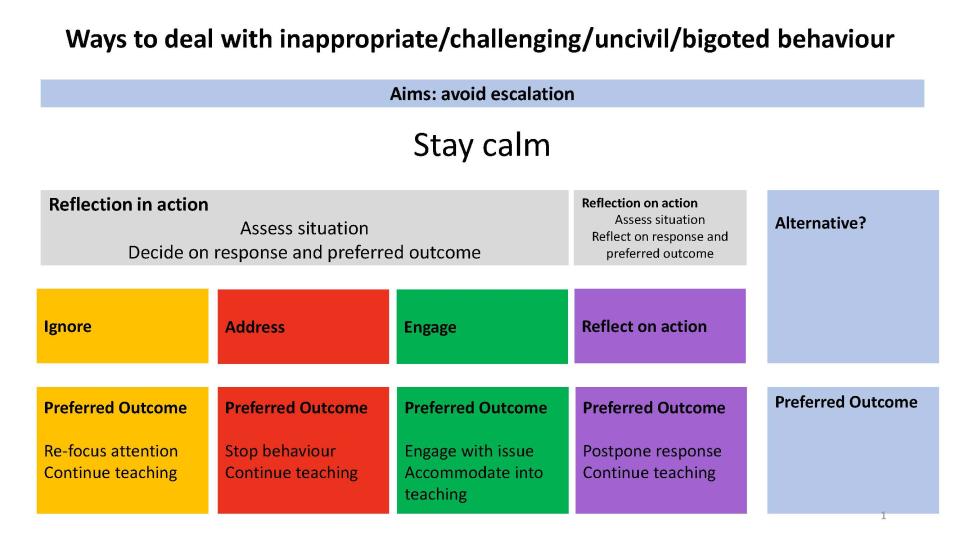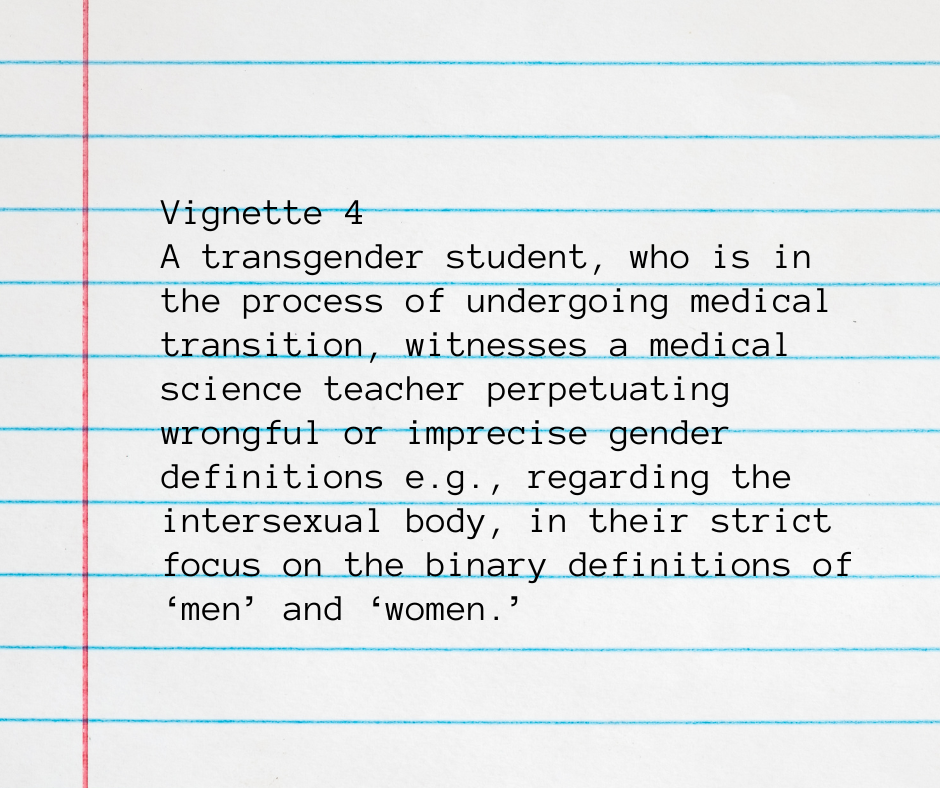Have you ever found yourself in a teaching or supervision situation where an inappropriate comment, question or behaviour caught you unaware and you didn’t know how to respond? We have, and we have heard university teachers share similar challenging situations. That’s why we created an open-access resource and workshop to prepare university teachers for unanticipated interactions in and outside the classroom – such as sexist, racist or transphobic behaviour, to name a few. This reflective tool uses real-life vignettes based on our own and colleagues’ experiences in teaching scientific topics, and it is meant to be used to stimulate discussion in small groups.
Let us introduce ourselves: our small team included two academic developers, a gender equality consultant and a computer science researcher. We were brought together via two special interest groups operating across Danish universities: Bias Aware Teaching and Learning (BATL) and Teaching and Learning in the International Classroom, hosted by the Danish Network for Educational Development in Higher Education.
Unanticipated behaviours range from persistent questioning by the same participant, which disrupts the flow of the teaching and distracts the class, to voiced prejudices, bigotry and even uncivil behaviour, which offends, discriminates and breaches an inclusive learning ethos. When we talk about inclusive learning, we mean learning that is ‘meaningful, relevant and accessible to all’ and where diversity enriches us all.
When teaching we are constantly navigating getting our message across as effectively and clearly as possible while fostering inclusive and respectful learning environments. How well a teacher cultivates and maintains such an environment is picked up by students. Students value teachers who can maintain the pedagogic flow, encourage discussion, explain difficult decisions – like changes in assessment deadlines, show humility when they make a mistake, and remain calm in tense situations, studies show.
Apart from maintaining the pedagogic flow, if we ignore behaviour which affects others, we let others down, and diminish the inclusive, safe environment. Even the most composed teacher can experience paralysis of inaction when confronted by unanticipated challenging behaviours. Teachers must think on their feet and respond while “in action”, with limited time for reflection. Such quick responses suggest System 1 thinking, where our emotional response outweighs our slower, cognitive System 2 response and therein lies the risk of hasty, biased reactive responses.
To help teachers overcome paralysis of inaction and hasty responses, we developed the Managing excluding behaviour and bigotry using a BATL tool workshop and resource. This resource is designed to stimulate discussion, reflection and sharing good practices. We have led the workshop in person and online. The following steps illustrate how to run the workshop for a wide range of settings and people.
Steps for using the Bias Aware Teaching and Learning tool:
Ownership of the examples by the workshop participants is important, as participants can work with challenges they recognise from their own professional context. Before the workshop, send out a survey where prospective participants are asked to share their own examples of challenging behaviour, exhibited by staff, students or visitors from a university context. Select some or all of these to use in the workshop. Occasionally, we supplement with other examples – all of which, in our case, come from Danish university contexts.
At the workshop or webinar, introduce research-based introduction slides that are provided via the BATL tool link, and share the tool, which you can see in figure 1 below. We refer to the resource as a “scaffold” because it offers a systematic approach to reflecting on educational situations where challenging behaviour has occurred.

The scaffold introduces three possible in-action responses to challenging behaviour:
- Ignore
- Address
- Engage
It also features a “Reflect on action” response, for when we have time to evaluate the situation and our in-action responses.
We based the scaffold’s design on our own ways of addressing challenging behaviour when teaching or supervising students. Although our individual responses to challenging behaviour were influenced by subject matter and context, our approaches tended to fall into the three categories: ignore it and hope the perpetrator stops, address it in order to make the perpetrator stop, or engage with it and integrate it into the class or discussion.
Curate a collection of relevant examples of challenging behaviour (vignettes), including some or all those pre-shared by the workshop participants. You could categorise the examples according to the type of behaviour e.g., discriminatory behaviour; excluding behaviour; harassment. If you are running the workshop online, share the collection of examples on an online platform where the participants can post their comments. Alternatively, in a face-to-face workshop you can share the vignettes by printing them out as handouts, see Figure 2 below.

Next, the participants work in small groups of two or three and are allocated a category of examples. We ask the group members to imagine they are the teacher where one category of examples occurs, and to discuss applying each of the three in-action responses and possible outcomes. For example, what do they think would happen if they chose to ignore the behaviour, to address the behaviour or to engage with it? If they have time, they are welcome to discuss another category or to apply the scaffold to their own examples of challenging behaviour they have experienced, observed, or heard about.
During the plenary, invite each group to share highlights from their discussions, and which approach or approaches they thought they would apply and why. We also welcome hearing about alternative approaches.
We recommend including contact information for staff and students regarding who to contact if they need further support on dealing with or reporting discriminatory or inappropriate behaviour.
The feedback from workshop participants is encouraging. It indicates that providing such a scaffold, curated examples, and a safe space for discussing how to manage challenging behaviour facilitates sharing and reflection. The workshop can also be especially supportive for those new to the teaching role, as they can share what they regard as challenging behaviour and safely test out different scenarios.
Donna Hurford is a senior academic developer at the SDU Centre for Teaching and Learning, University of Southern Denmark (SDU); Valeria Borsotti is a computer science researcher in the Department of Computer Science at the University of Copenhagen.
If you found this interesting and want advice and insight from academics and university staff delivered direct to your inbox each week, sign up for the THE Campus newsletter.




comment